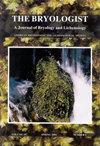Where and how many new additions to the liverwort flora of Vietnam may be found?
IF 1.5
4区 生物学
Q4 PLANT SCIENCES
引用次数: 4
Abstract
Abstract. The study of the liverwort and hornwort flora of Vietnam has received additional interest in recent years as many new records have been revealed. This raises the question of the number of new records that may possibly be found and where they should be located. Data on new liverwort occurrences within the last 55 years were summarized to identify whether the discovery ‘plateau’ has been reached. The bioclimates of the localities of the newest records were examined using canonical correspondence analysis (CCA) to determine whether there was any regularity in the distribution of the new records. Progress in liverwort flora knowledge has not reached a plateau; moreover, within recent years, the number of recorded species has grown quickly. The new records are located in mountainous areas, and climatic characteristics of localities are different from those of the dominant low elevations in the study area. At the current stage 573 taxa (568 species plus 5 varieties) are known in Vietnam. They belong to 105 genera of 46 families. Vietnam has recently become a flagship country in the study of liverwort diversity in Indochina, and the regularities found in the country may be applied to other countries in this macroregion. Higher numbers of recorded species than are now known may be found in all Indochina countries. Mountainous land areas possess the potential ability to harbor a high number of new records.越南的苔类植物群在哪里和有多少新增加?
摘要近年来,随着许多新记录的发现,对越南苔属和角苔属植物区系的研究受到了更多的关注。这就提出了一个问题,即可能找到的新记录的数量以及它们应该放在哪里。总结了过去55年里新发现的苔类植物的数据,以确定是否已经达到了发现的“平台期”。利用典型对应分析(canonical correspondence analysis, CCA)对新记录所在地区的生物气候进行了研究,以确定新记录的分布是否具有规律性。对苔类植物区系的了解还没有达到停滞;此外,近年来,有记录的物种数量增长迅速。新记录位于山区,其气候特征与研究区低海拔地区的气候特征不同。目前在越南已知573个分类群(568种加5变种)。它们隶属于46科105属。山地地区拥有大量新记录的潜在能力。
本文章由计算机程序翻译,如有差异,请以英文原文为准。
求助全文
约1分钟内获得全文
求助全文
来源期刊

Bryologist
生物-植物科学
CiteScore
2.40
自引率
11.10%
发文量
40
审稿时长
>12 weeks
期刊介绍:
The Bryologist is an international journal devoted to all aspects of bryology and lichenology, and we welcome reviews, research papers and short communications from all members of American Bryological and Lichenological Society (ABLS). We also publish lists of current literature, book reviews and news items about members and event. All back issues of the journal are maintained electronically. The first issue of The Bryologist was published in 1898, with the formation of the Society.
Author instructions are available from the journal website and the manuscript submission site, each of which is listed at the ABLS.org website.
All submissions to the journal are subject to at least two peer reviews, and both the reviews and the identities of reviewers are treated confidentially. Reviewers are asked to acknowledge possible conflicts of interest and to provide strictly objective assessments of the suitability and scholarly merit of the submissions under review.
 求助内容:
求助内容: 应助结果提醒方式:
应助结果提醒方式:


